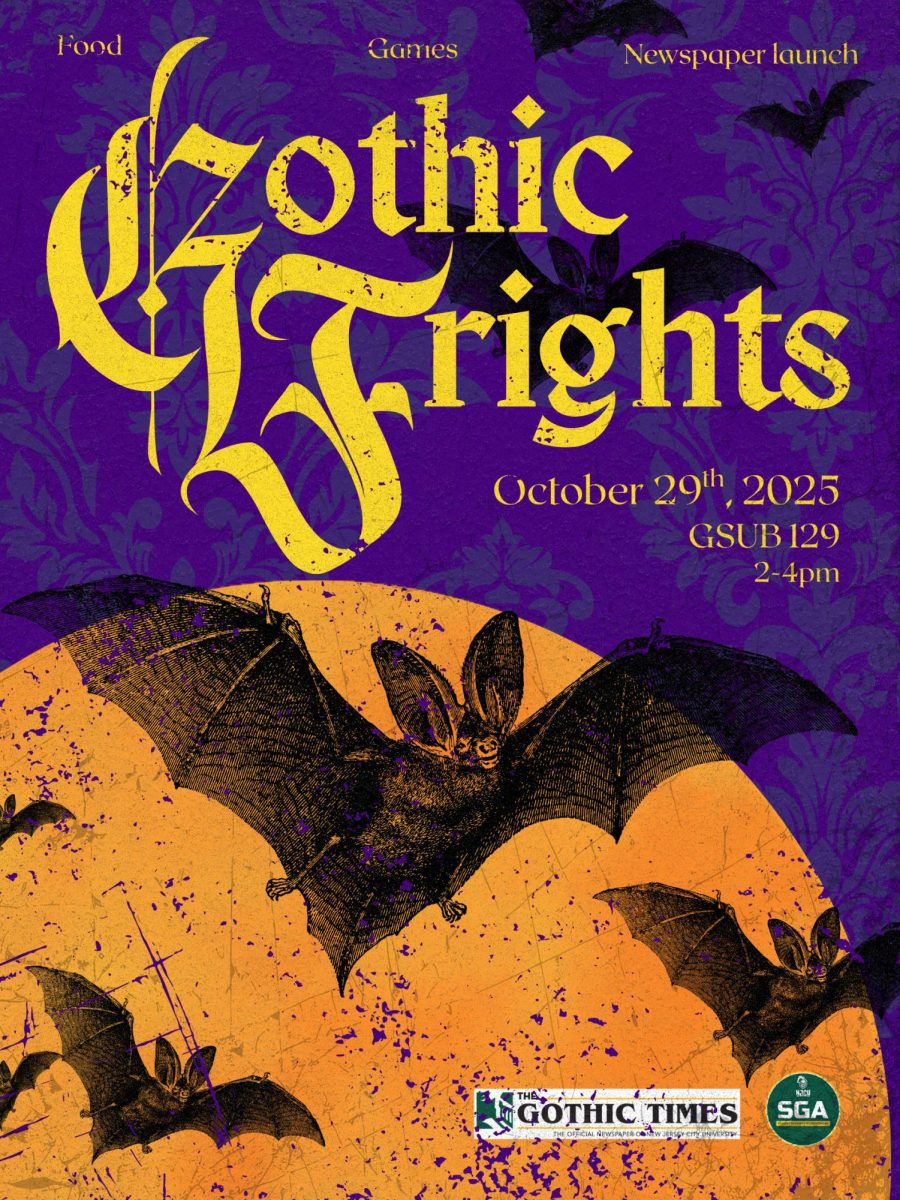Bowling
July 25, 2016
The thud of the average 10 pound polyester coverstock sphere hitting and wheeling down the synthetic lane until it impacts the ten white Coca Cola bottle shaped pins as they clang against one another is what you will mostly hear and see here.
High five smacking, fist pumping, and laughter and cheers from people of all ages, like those in their 20s, 40s, and 60s, are other things you will witness and hear in this place.
Even five and eight year old kids will join in on the fun as they celebrate birthday parties and munch down on pizza and soda. They place the ball, which they don’t have the strength to push down the lane by themselves, on a small and green slide for the ball to roll slowly down the lane, which has bars blocking the gutters on the side so the sphere doesn’t fall into it and ruin their fun.
Those kinds of things happen every day when you walk into the Hudson Lanes bowling alley, located on 1 Garfield Avenue in Jersey City, NJ. It’s actually something you will see at any given bowling alley really.
Most people know the game of bowling, as just that, a game. Like playing cards or monopoly, they don’t take it as serious. Typically just putting two of their fingers and a thumb in three holes of the bowling ball and whipping it down the 60 ft. long shiny wooden looking lane.
Then just watch the heavy ball roll all the way to the end in a straight line to where the set of ten pins lie, assuming of course the bowling ball didn’t fall into one of the two gutters on the side.
“It’s more than putting three fingers in a bowling ball and rolling down 60 ft. of synthetic wood in hopes to knock down coated pieces of wood,” said New Jersey City University (NJCU) Women’s Bowling Head Coach Jarell J. Smith, a 30-year old Jersey City, NJ resident. “It may not be as physical as basketball or baseball, but the physics involved along with the mental game needed is comparable to golf. Having that knowledge of what’s needed to excel would assist in the understanding of why bowling should be considered a sport.”
Like the coach says, bowling is not just a game, it’s a sport, and a once quite popular sport. And the people who love the game, really really love it. The problem is there just isn’t as many people like that as there used to be.
Bowling had its golden age from around 1940 to 1960, but its origins can be traced all the way back to 3200 B.C.
The Professional Bowlers Association (PBA) was born in 1958 and its popularity soared even further. Bowlers were like rock stars and guys like Don Carter, Dick Weber, Carmen Salvino, and Earl Anthony led the pack. They were household names.
The number of sanctioned bowling alleys in the United States peaked at about 12,000 in the mid-1960s, while membership in the American Bowling Congress (ABC) was also at its highest at just under 4.6 million male bowlers.
If there was any doubt about how popular bowling was in the U.S. at the time, it went away quickly when Don Carter inked a $1 million multi-year endorsement contract with Ebonite International in 1964. He was the first athlete of any kind to do so.
To show you how much more money Carter got from his endorsement in comparison to athletes in other sports, golfer Arnold Palmer earned just $5,000 in 1961 endorsing Wilson golf equipment and National Football League (NFL) quarterback Joe Namath made just $10,000 in 1968 from his endorsement deal with Schick Razor. Needless to say it was an enormous difference.
And it wasn’t just endorsements, bowler Harry Smith made more cash than Major League Baseball (MLB) Most Valuable Player (MVP) Sandy Koufax and NFL MVP Y.A. Tittle combined in 1963. Bowling was at its pinnacle. Which begs the question: what happened or what is happening?
“I believe because bowling alleys will get torn down,” said 18-year old Autumn Fortunato, an NJCU bowler from Staten Island, NY of the decline of bowling’s popularity. “so it will allow for fewer people to go bowl if they don’t have anything close to them to go to.”
From 1998 to 2013, the number of bowling alleys in the U.S. fell from about 5,400 to 3,976, and the number only continues to get lower.
Some say the popularity has gone down because of the fact that many don’t actually recognize bowling as an actual sport, even though the PBA exists and the National Collegiate Athletic Association (NCAA) has bowling. Well, at least for women it does.
“I think people say bowling isn’t a sport because they really will only see what we call open bowlers, which means people who just go bowling with their friends, and don’t really know how to bowl.” said Fortunato, who has been bowling since she was around 8-years old and started to take bowling more seriously at around the age of 13. “People don’t realize how much actually goes into being good at bowling, you can’t just pick up the ball and suddenly have form and hook on the ball. People saying bowling isn’t a sport hurts me because I work really hard to be good, and you have to stay in good health, and you have to condition yourself.”
“Bowling is definitely a sport,” said 20-year old Rachel McIntyre, another NJCU bowler and teammate of Fortunato from Drexel Hill, PA. “You want to talk specs, the NCAA considers it a sport.”
The NCAA founded women’s bowling fairly recently, in 2004. The fact that the NCAA only sponsors women’s bowling and not men’s is even more surprising, considering that the sport was once considered more popular among men.
But now that’s clearly changing. In 2007, a study done by the research firm White Hutchinson showed that 46 percent of all bowlers were women.
With those numbers continuing to grow every year, you could imagine what the percentages are today, or what they will be in the next five years if the trend continues.
“Bowling I think is more popular with women because women like to be role models for people growing up,” said Fortunato. “Within bowling we can do that because the popularity of bowling has declined but we are building it back up, and we are building it back up with more women’s bowling. Bowling is also one of the few sports where women go against men on a daily basis, so it also allows for women to show that they can be just as good if not better than men at something.”
Other reasons for the decline could be because of the lack of fully understanding the game of bowling by the average joe.
“Bowling is definitely more complex that what the average person thinks,” said Fortunato. “There are so many reasons. Every bowling ball, not including house balls, have different cores, and different surfaces that make it have more hook or less hook. Along with the ball itself, the way a person drills the ball will also allow someone to determine how strong the hook will be on the ball. You can add an extra hole in the ball, where no fingers go, but it just allows for more hook on the ball for lanes that have higher amounts of oil. The lanes have oil on them, which can be changed, and that also will determine where you can place the ball to get it to hook back to get a strike. The more oil there is the more likely it is for someone to use a ball with a dull surface and an extra hole, to allow the ball to have a greater hook, to overcome the amount of oil. The less oil there is, the ball a person will go to will be something weaker, with a shinier finish on the ball, because with less oil the ball will move more. So with less oil, people tend to use less hook.”
“You have to learn how much lane conditioner is on a given lane, and create an angle of trajectory with your placement on the lane and the bowling ball that’ll strategically knock down all the pins at one time,” said Smith of the complexities of the sport. “Then, when you leave pins on the deck, you now have to re-strategize where you’re standing and create a new angle/line to knock down what’s left. Another thing, when there’s a lot of lane conditioner (oil) or if there’s too much of it….what do you do?”
“People say it’s not a sport because anyone can do it,’” said McIntyre. “But not everyone can do it, especially not competitively.”
According to PBA.com, there are nearly 4,300 members, representing Australia, Bermuda, Canada, China, England, Finland, France, Germany, Japan, Korea, Sweden, the United States, and Venezuela in the PBA. A relatively small number considering the global scope of the game.
Bowling alleys were, and many still are, built with mini bars, food stands, and even feature disco lights to create a nightclub like atmosphere. Most of these types of bowling alleys can be found across the river in New York City.
“I know bowling alleys that are more of a league house, and I know bowling alleys that are more for open bowlers.” said Fortunato. “With galactic bowling, it allows you to have that realization that bowling doesn’t always need to be competitive, and that you can just go there and have fun and not worry about score. I don’t really think it takes away the focus of bowling, but it does add on to why people would think it isn’t a sport, but again those people don’t necessarily see the competitive side of bowling where it is really competitive.”
Clearly, bringing in those extra commodities is done so to attract the non-bowler. It’s just as essential as the game, if not more, for these bowling centers to survive.
“I think it’s great for the sport to bring back the recreation and enjoyment aspect of things,” said Smith. “However, it is disheartening to see and hear of bowling centers not catering to their regular bowlers that participate in their weekly leagues and tournaments for those that have a fleeting interest in the game.”
Smith went on to say that “more bowling alleys should find a happy medium to where they can increase their daily/weekly revenue with parties and events while keeping the interest and more consistent revenue of their league bowlers. It should not always be about the bottom-line of corporate entities, but we’re in an age of where that mentality is trending.”
The sport of bowling seems to be America’s favorite recreational activity, according to multiple studies and surveys. Maybe all hope is not lost.
According to White Hutchinson, in 2014, 52 million Americans go out and bowl and the average bowler visits a center 13 times per year.
The research firm also insinuates there might even be a revival of the sport coming. White Hutchinson also reported that more than one third of children, between the ages of 6 and 18, bowl and 12% of them list bowling as their favorite activity as well.
The study also finds that children are 80% more involved in bowling than any other age bracket, and we all know that is one of the keys for a sport to become popular; reach the kids.
If a comeback is coming, the youth have to continue to be interested in the sport and be willing to carry the torch.
Bowling being named as one of the eight shortlisted sports to be played for the 2020 Summer Olympics in Tokyo, Japan should help in keeping and promoting more interest for the game.
“I think for the popularity of bowling to rise again, people would need to promote the fun of the sport,” said Fortunato. “but also how the fun is also competitive. With bowling you can travel the world, and I think that should also be promoted.”
Bowling has been through a lot in its history. It’s had its ups, and it’s been going through some of its downs. But it should be respected as the sport that it is.
Who knows, maybe one day the sport will rise again. It seems to be on the right track, albeit a slower one, but a steady and right one nonetheless. With the fun people have while playing it, you just never know.
“While playing, I’d say my favorite aspect is bowling and the overall enjoyment of the game with my friends,” said Smith. “Whether in league, tournament, practice, or trash-talking for a waged amount, there’s always something new to experience.”












